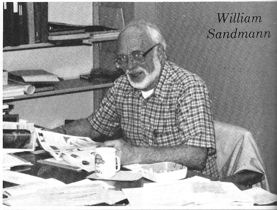William H. (Sandy) Sandmann (1928–2014)
June 16, 2016
William (Sandy) Sandmann, physics professor at Harvey Mudd for thirty years, passed away at his home in Port Townsend, Washington, on 21 March 2014, at age 86.
Sandy graduated from Reed College and received a PhD in nuclear physics from University of Utah. He taught for a few years at Grinnell College before coming to Harvey Mudd in 1963. After several years here, Sandy switched his specialty from nuclear physics to start the college’s observational astronomy program.
Over the next twenty years, Sandy directed senior research projects for more than thirty physics majors. Most of this work was done at the Table Mountain Observatory, jointly operated by JPL, Pomona College and HMC. Sandy was largely responsible for the Table Mountain telescope, where he spent many nights developing instrumentation and observing stars, often accompanied by student researchers. He had a major influence on many of these research students. Scott Smith (HMC ’76) said, ‚ÄúSandy was a great guy who had the singularly most direct impact on my life and career of anyone I ever came in contact with outside my parents.‚Äù
If he wasn’t at Table Mountain, Sandy was most likely found around one of the teaching labs. His interest in the telescope linked well with his development of experiments for optics lab, and he also used his background in nuclear physics in revising senior lab. Dick Haskell commented that Sandy had an excellent, intuitive grasp of how to make or fix electronics instruments. ‚ÄúHe could always get something to work.‚Äù This knowledge proved invaluable in Sandy’s contributions to the junior electronics lab. He was especially good at setting up and running introductory labs, generously sharing his insights with new faculty and laboratory staff learning the ropes in these courses.
Sandy also played a leading role in the design and construction of the Libra complex (the academic cluster centered on Sprague Library) around 1970, again when the laboratory space was expanded a decade later, and finally in 1986, when new programs in biology and computer science and expansions in other departments led to the need for more laboratory facilities.
Above all, Sandy loved interacting with students on a one-to-one basis and working with things. He was always trying out and fiddling with new gadgets, scientific or otherwise. Jim Eckert recalls Sandy showing him his new Red Ryder BB gun, which they decided to test in Jim’s lab, just as a tour group of prospective students came by.
Sandy is survived by Pat, his wife of thirty years, and three daughters from a previous marriage – Nicola, Rachel, and Paula